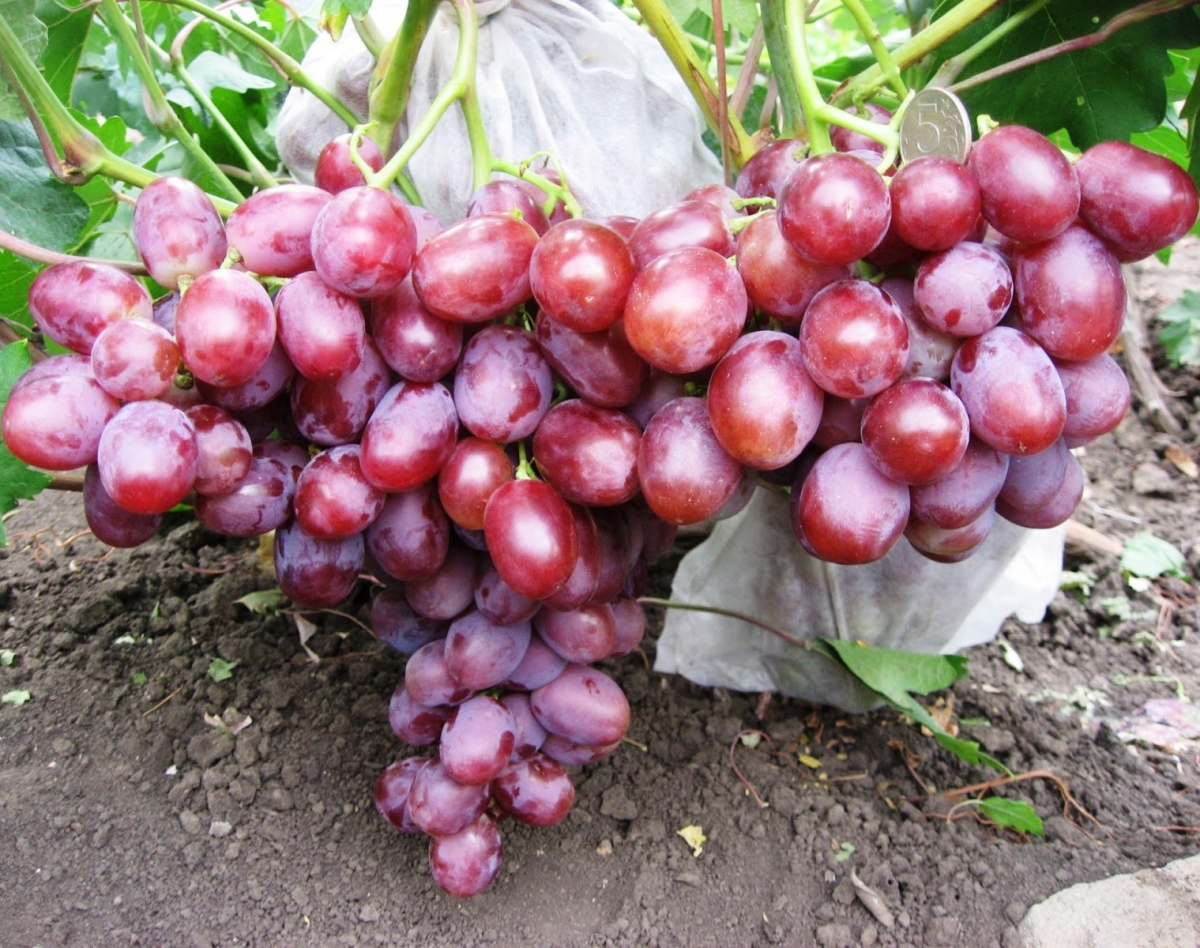
For people engaged in growing grapes in the northern and central regions, there was also the opportunity to successfully cultivate the berry. It was for winegrowers of the north-central strip that the amateur-originator Viktor Krainov brought the hybrid form of the berry and gave it the name "Lowland".
Content
Description
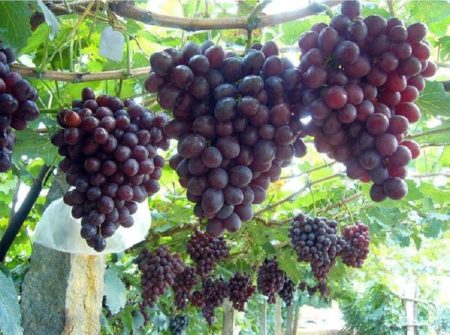
Hybrid "Lowland", which is often called the "Krainov Gift", is intended to be used without any processing. It is simply impossible to pass by his large bunches with large berries. Belongs to a subgroup of pink varieties, although the color of the berries varies depending on the maturity. From yellow-coral, by autumn, the fruits turn into purple-red.
Grape It is highly resistant to adverse growing conditions. Therefore, winegrowers successfully cultivate it not only in the southern regions, but also in the northern regions. Bushes shelter for the winter only in those areas where frosts drop below -27 degrees.
It has elegant clusters in combination with dense large berries. It has good keeping quality, stored in the refrigerator for about 4-5 months. At the same time, even at the end of the shelf life, the berries remain attractive, juicy and tasty.
Propensities for the appearance of small berries in large clusters of varieties not observed even when cultivated in adverse climates. And, thanks to the dense skin, the berries are practically not damaged by bees and wasps.
The color of the "Lowland" berries changes depending on the exposure to ultraviolet light during ripening. The more the berry is illuminated by the sun's rays, the more dye is present in it, which gives color saturation. The sucrose level in the fruits reaches 17% -19%, and the berries have an aftertaste of cherry berries.
It is characterized by good transportability, withstanding long-distance transport without loss of presentation. The mass of the bunch on average reaches 650g-750g, however, when the plants are treated with growth stimulants, a separate one can reach 2.5 kg.
Characteristics
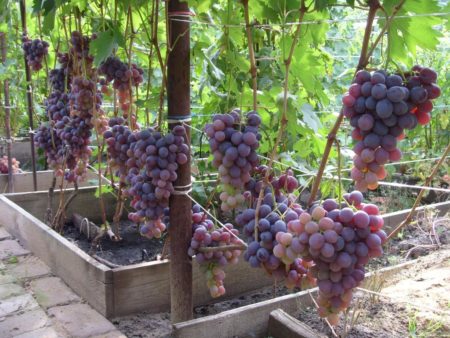
The hybrid has an average maturity. Depending on the growing region, the growing season from budding to the stage of technical maturity is 120-150 days. Is different:
- maturation of the vine during the growing season up to 60% of the height of the bush;
- powerful growth power of shoots, which in the lower part have a red-pink hue;
- highly developed root system;
- large clusters with conical berries of moderate density;
- a fruit measuring 3.5 cm by 2 cm weighing 9g-13g;
- staining berries 14 days before the onset of technical maturity;
- fleshy juicy pulp of fruits with a harmonious cherry aftertaste;
- completely eatable, albeit dense skin;
- stable yield of up to 6.5 kg of fruit from one bush;
- high sugar content up to 19%;
- the presence of 1-3 seeds in one fruit;
- low acid content in the pulp - not higher than 0.8 g per 100 ml of juice;
- frost resistance up to -27 degrees.
Benefits
Key positive qualities varieties:
- extended ripening periods;
- the possibility of cultivation in the northern regions;
- full ripening of stems;
- 99% pollination;
- stable fruiting;
- lack of peeling;
- high sugar content in fruits;
- good presentation;
- increased transportability;
- ability to withstand frosts without shelter up to -27 degrees;
- resistance to powdery mildew of oidium, downy mildew, botritis;
- unattractiveness for wasps.
disadvantages
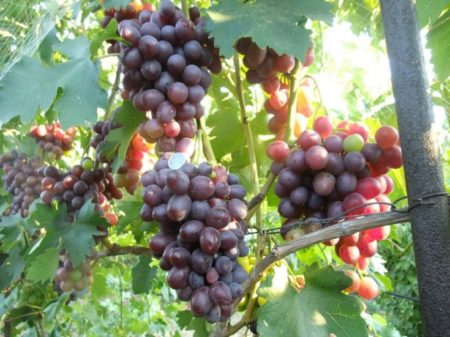
Vineyards of this varieties not particularly whimsical to care for. However, there are some requirements for agricultural technology:
- each planted plant requires a cultivation area of at least 2.5 m-3 m during cultivation, so you need to plant bushes at a great distance from each other;
- clusters and shoots that have formed should be normalized, since, leaving the entire crop, the size of the fruit will be two to three times less;
- at a steady temperature of air for two weeks more than thirty degrees, varieties reduced immunity to powdery mildew spores of oidium. Therefore, preventive spraying with fungicides is necessary.
Pollinating varieties
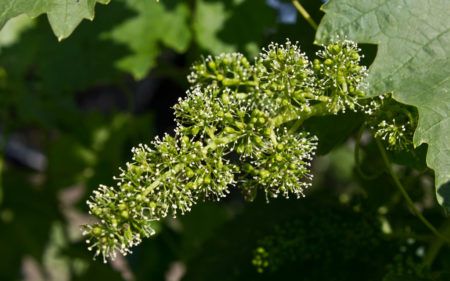
In regions characterized by a hot climate, long dry winds or long rains, near the "Lowland" growers plant pollinating varieties. Under adverse environmental conditions, varieties with a female type of flower can be planted. Many novice growers mistakenly believe that this can not be done, as there will be pollination. However, such an agricultural method does not in any way impair the quality and productivity of the fruit. Functionally female type of flower have:
- Mascot;
- Laura;
- Victoria;
- Bashkir early;
- Guna;
- Madeleine Anzhevin;
- Pukhlyakovsky;
- Chaush;
- Moldavian black.
Features of agricultural technology
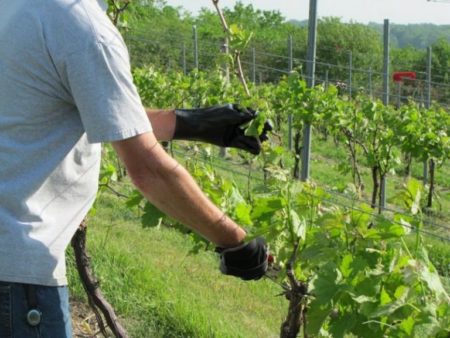
The hybrid is a lover of open sunny areas, the lack of ultraviolet radiation negatively affects the development of the bush and the quality of the fruit. Vines do not like strong winds, so vineyards need to be broken in a place protected from drafts. Of great importance is the landing method. In March-April, plant "not awakened" chubuki or dig in layering. At the end of May, plant blooming cuttings or plant lignified stepsons.
Features worth paying attention to:
- Lighting conditions. Choose southern sites for landing. From bushes planted on the northern, eastern and western sides, the harvested clusters will be two to three times less. Sugar content of berries is reduced, and palatability is reduced.
- Draft Protection. Branched shoots grape with generative organs are very sensitive to strong gusts of wind, after which some of them simply fly around. To deal with drafts in the garden, flower beds with tall perennials and small hedges that will serve as barriers also help to separate the zones.
- The composition of the soil. Hybrid "Lowland" will bear fruit well only in the soil, which has a porous structure with a large number of organic residues.
- The groundwater. Located aquifers at a depth of less than two meters will lead to decay of the roots of the vineyards. With the proximity of groundwater at a depth of 0.30 m - 1.8 m shrubs will need drainage with a layer of at least half a meter.
- The relationship of plants on the plantation. The hybrid is distinguished by increased branching, so plant seedlings at a distance of 3m-4m from each other. Improper planting will lead to a decrease in productivity, inhibition of plant development, and complication of care measures.
Planting seedlings
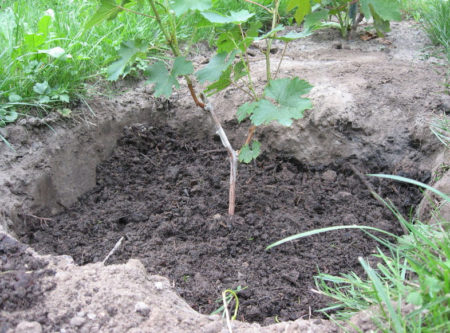
In late April and early May, it is necessary to prepare the soil in order to plant rooted cuttings.To do this, prepare the planting holes, which are filled with the required amount so that they nourish the plants until the fall. In addition, prepare the wells two weeks before planting seedlings for subsidence:
- dig a hole 0.7m-1m deep and wide;
- make fertilizers: potassium salt 50 g, superphosphate 60 g, nitrate 50 g, potassium permanganate, parchment 5 g;
- pour two buckets of well-rotted cow manure on top of the fertilizer;
- mix the mixture with one bucket of garden soil to prevent burns by young roots;
- before planting, lower the root system of the seedlings for half an hour in water, and then for one hour in a solution of "Epina" or "Zircon";
- after soaking, lower the stalk into the ground to the level of the zone of transition from the root to the stem, gradually falling asleep with soil;
- to consolidate the soil while falling asleep, gradually pour water into the hole;
- after planting, fill the future bush with two buckets of water;
- drive near the planted chubuk 4 metal or wooden stakes around the perimeter in order to easily cover the plants under adverse weather conditions;
- on the soil around the planted seedling, lay covering material from grass, hay or straw 25cm-30cm high.
Bush formation
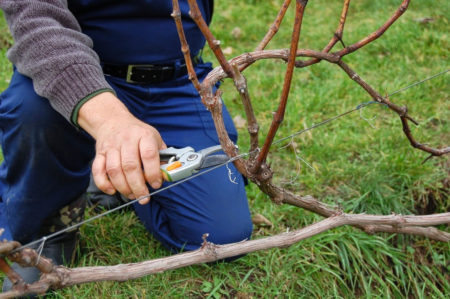
In the first years after planting the cuttings, the main task is to properly form a bush and create favorable conditions for the development of the vegetative mass:
- in the first cultivation season, before the onset of frost, two stems about two meters long should be grown on the plant with well-ripened leaf attachment sites. You can achieve a well-ripened vine with timely watering and the introduction of complex fertilizers;
- in the second year after planting, after the beginning of the growth of the lashes, break out the excess, forming a bush in four vines. For a year and a half after planting the cuttings, its root system has grown five times, so the number of top dressings for the second season should be doubled. Before wintering, shorten each of the four stems to 1m-1.6m;
- for the third season, install a support structure for the garter of the plant. After the bushes are opened in May, shorten each stalk to 50cm-70cm. Form a bush of eight stems, systematically cutting out all the extra stepsons throughout the season. Before autumn shelter, shorten each vine to 1m-1, m.
Preparation for winter
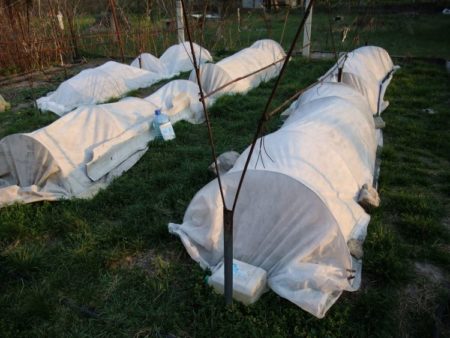
Preparing the hybrid for frost is an important and crucial moment. In the first years of life, a young seedling must be sheltered even in those regions where the air temperature drops only below -10 degrees.
- a plant that is not affected by diseases will easily survive wintering, since the spores of the fungi living on the vine will not weaken it. Therefore, for a good wintering all summer to conduct preventive treatment of bushes with protectants from diseases. Having looked closely at the bush in early autumn, remove each affected shoot;
- after autumn pruning, treat the bushes with the following preparations: Cabrio Top, Ridomil Gold, Shavit, Polycarbacin, Sumileks, Nitrafen, Vectra;
- cover the bushes at air temperatures from -7 to -8 degrees;
- to increase the immunity of the vineyard to keep plants under cover as little as possible;
- take care that the covering material is warm, light, and also “breathes well”. Suitable for shelter: hay, reeds, corn stalks, agrofibre.
Reviews
Grape growers who planted a hybrid form in the plots grape "Lowland", share their impressions:
Alexey Stary Oskol
My bush "Lowland" is already four years old. Fertilization took place in the rain last season. I didn’t even hope for a crop. But everything went just fine. The inflorescences were pollinated just perfectly, and from the bush I took off 4 kg of bunches, which also circled around the wasp side.
Nelly Kiev
I want to share my observations on the stability of this variety "Lowland". This year, the grapes were left on the old site, as it was no longer possible to transplant it. In the neighboring plots, the entire vineyard "burned out" from the mildeu. And the "Lowland", growing in the shadow of three huge apple trees, managed to give a few bunches and looked completely intact.
Transportability, resistance to pathogens and good taste make the "Lowland" in demand among many wine growers.




 Non-covering winter-hardy grape varieties for Moscow region
Non-covering winter-hardy grape varieties for Moscow region How to keep the vine in winter
How to keep the vine in winter When can I transfer grapes to another place in the fall
When can I transfer grapes to another place in the fall How to cover and prepare grapes for the winter in the suburbs
How to cover and prepare grapes for the winter in the suburbs